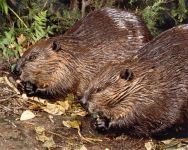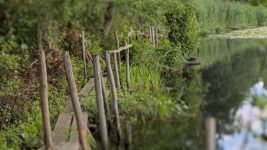Beaver Tales from Unexpected Wildlife Refuge, August 2021
Bridge over main pond dike
With the end of summer in sight, and the promise of cooler temperatures, we expect to see an increase in visitors during the next few months. Due to record rainfall over the past ten years, there is a need to raise the boardwalks along many of the Refuge trails from their original height. We are considering building new environmentally approved boardwalks throughout the Refuge, which will require approval from the New Jersey Pinelands Commission and the New Jersey Department of Environmental Protection. We are in the process of consulting with an engineer to determine the specifics, including the costs of construction. This will require a major financial investment. We will be seeking grants to fund the project, but if you would like to help, please consider making a donation. Keeping the trails navigable is vital to the involvement of the public and longevity of the Refuge.
manager@unexpectedwildliferefuge.org to schedule.
Kids' corner section in this edition.
Running a wildlife Refuge is not only physically and emotionally demanding, there are always expenses with which to deal. Although we are frugal in how we spend Refuge funds – having only one employee and an all-volunteer Council of Trustees – we need your help in ensuring the continuation and longevity of the Refuge. We hope you will take the time to make the most generous donation you can...now . Please know that we – and the wildlife – are grateful for your continued support.
Contents of this month's newsletter:
Refuge news
Great egret on beaver lodge
Green heron juvenile
Belted kingfisher
Ruby-throated hummingbird
Local photographer visits Refuge
Beavers in the news
Here are some recent news media articles concerning beavers. You can see our entire and growing list, a tribute to this wonderful keystone species, in our Beavers in the News page . If you come across a news item on beavers, please send us the link so that we can consider it for inclusion.
Baby beaver born on Exmoor for first time in 400 years , by Phoebe Weston.
Mother and kit
A baby beaver has been born on Exmoor for the first time in 400 years after two adults were successfully reintroduced by the National Trust in January 2020.
How a group of beavers prevented a wildfire and saved California a million dollars , by Graig Graziosi.
Beavers
Lynnette Batt, the conservation director of the Placer Land Trust, which owns and maintains the land where the floodplain is located, told The Sacramento Bee that she was amazed by the 'awesome' success of the project.
Campaigns for wildlife in New Jersey
Bee on flower
Save the bees. Tell your state Legislature to restrict bee-killing pesticides. Please sign and share this petition :
https://environmentnewjersey.org/feature/nje/save-bees
American black bears
2021 Bear Hunt Update https://www.nj.gov/dep/fgw/bearseason_info.htm
Snapshots of life at the Refuge
Black vulture
Young black vulture at cannery
Red-spotted purple butterfly
Red-spotted purple butterfly
Red-spotted purple butterfly along boundary trail
Beaver eating lily pads
Beaver partakes in midday snack of lily pads
Daisy fleabane
Daisy fleabane grows from uprooted tree
Eastern amberwing dragonflies
Odonata activity on the main pond
Giant leopard moth
Giant leopard moth at Miller House
Kids' corner
When children have opportunities to observe wildlife, a whole new world of wonder can open up. Let's see what it's like to observe the wildlife at UWR from a kid's perspective.
Beaver slapping tail
Beavers by Sylvia Cudrak, age 7
Take action to help wildlife at the Refuge
As part of the vital and globally unique ecosystem that is the Pine Barrens, the Refuge is home to many endangered and threatened species. Please make a pledge to sponsor a Refuge habitat or choose to support one of the species of animals who call this protected land 'home'. You can easily do this through an automatic monthly PayPal donation (you do not need a PayPal account, just a credit card). Go to our Donate page to make your choice and subscribe. Your recurrent donations will be used, as with all our income, to continue protecting the Refuge from harm and allowing the inhabitants to live freely.
Wetland habitat: $30.00
Pine forest habitat: $25.00
Bald eagle: $20.00
Beaver kit: $15.00
Muddy Bog
Bald eagle
Beaver
River otter: $15.00
Eastern box turtle: $15.00
Red fox: $10.00
Your personal favorite: $20.00
All habitats and animals: $60.00
River otter
Eastern box turtle
Red fox
Hummingbird
Continuing reminder about helping us help wildlife today We depend entirely on the support of our donors for our day-to-day expenses! As we approach the end of the year, we still have not received sufficient donations to cover our nominal budget for the year . We know that you have limited resources and need to consider which of numerous worthwhile causes to support. We hope, however, that you can again find it possible to give us a donation today of any amount. We and the wildlife need your support now .
Contact us
Unexpected Wildlife Refuge
http://unexpectedwildliferefuge.org/
info@unexpectedwildliferefuge.org







